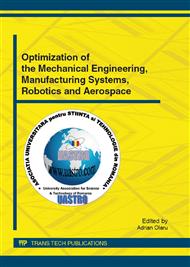[1]
M. Meliß. Regenerative Energiequellen - Praktikum, Springer (1997).
Google Scholar
[2]
T. Markat and L. Castañer. Photovoltaics - Fundamentals and Applications, Elsevier (2006).
Google Scholar
[3]
A.B. Afarulrazi, W.M. Utomo, K.L. Liew and M. Zarafi. Solar tracker robot using microcontroller. Proceedings of the International Conference on Business, Engineering and Industrial Applications - ICBEIA, Kuala Lumpur, 2011, pp.47-50.
DOI: 10.1109/icbeia.2011.5994256
Google Scholar
[4]
A. Coelho and R. Castro. Modeling and validation of PV power output with solar tracking. Proceedings of the 3rd IEEE International Conference on Power Engineering, Energy and Electrical Drives - PowerEng, Malaga, 2011, pp.1-6.
DOI: 10.1109/powereng.2011.6036500
Google Scholar
[5]
N.M. Dehelean and L.M. Dehelean. A mirror tracking mechanism. Mechanisms, Transmissions and Applications - Mechanisms and Machine Science, Vol. 3, No. 2 (2011), pp.111-123.
DOI: 10.1007/978-94-007-2727-4_10
Google Scholar
[6]
L. Guo. Design and implementation of a two-axis sun tracking solar power system. Journal of Engineering Technology, Vol. 28, No. 1 (2011), pp.34-39.
Google Scholar
[7]
M. A. Kadam and S.B. Garg. Exploring regions of application of single and double axis solar tracking systems. Proceedings of the International Conference on Advances in Mechanical Engineering, Surat, 2009, pp.342-346.
Google Scholar
[8]
B. Mokhtari, A. Ameur, L. Mokrani, B. Azoui and M.F. Benkhoris. DTC applied to optimize solar panel efficiency. Proceedings of the 35th Annual Conference of the IEEE Industrial Electronics Society - IECON, IEEE, Porto, 2009, pp.1122-1127.
DOI: 10.1109/iecon.2009.5414681
Google Scholar
[9]
I. Petrović, I. Gašparac and M. Vražić. Comparison of expected and measured values of luminance sensors in dual-axis photovoltaic positioning system. Proceedings of the 19th International Conference on Electrical Machines, Rome, 2010, pp.1-4.
DOI: 10.1109/icelmach.2010.5608081
Google Scholar
[10]
D. Puiu, D. Floroian and F. Moldoveanu. DASTS: distributed architecture for sun tracking system mounted on mobile platform. Bulletin of the Transilvania University of Braşov, Series I: Engineering Sciences, Vol. 4 (53), No. 1 (2011), pp.143-150.
Google Scholar
[11]
S. Seme, G. Stumberger and J. Vorsic. Maximum efficiency trajectories of a two-axis sun tracking system determined considering tracking system consumption. IEEE Transactions on Power Electronics, Vol. 26, No. 4 (2011), pp.1280-1290.
DOI: 10.1109/tpel.2011.2105506
Google Scholar
[12]
A.K. Sinha. Design and testing of PV maximum power tracking system with Matlab simulation. Proceedings of the IEEE Region 10 Conference - TENCON, 2010, pp.466-473.
DOI: 10.1109/tencon.2010.5686701
Google Scholar
[13]
Q. Wang, J. Zhang, R. Hu and Y. Shao. Automatic two axes sun-tracking system applied to photovoltaic system for Led street light. Applied Mechanics and Materials, Vol. 43 (2011), pp.17-20.
DOI: 10.4028/www.scientific.net/amm.43.17
Google Scholar
[14]
C. Alexandru and C. Pozna. Simulation of a dual-axis solar tracker for improving the performance of a photovoltaic panel. Proceedings of the Institution of Mechanical Engineers, Part A: Journal of Power and Energy, Vol. 224, No. 6 (2010), pp.797-811.
DOI: 10.1243/09576509jpe871
Google Scholar
[15]
C. Alexandru. Software platform for analyzing & optimizing the mechanical systems. Proceedings of the 10th IFToMM International Symposium on Science of Mechanisms and Machines – SYROM, Braşov, 2009, pp.665-677.
DOI: 10.1007/978-90-481-3522-6_56
Google Scholar
[16]
I.N. Tatu and C. Alexandru. Design and simulation of a photovoltaic string with tracking mechanism. Environmental Engineering and Management Journal, Vol. 10, No. 9 (2011), pp.1363-1370.
DOI: 10.30638/eemj.2011.194
Google Scholar
[17]
E. Eich-Soellner and C. Führer. Numerical Methods in Multibody Dynamics. Teubner (2008).
Google Scholar
[18]
N.V. Orlandea. ADAMS - theory and applications.Vehicle System Dynamics, No. 16 (1987), pp.121-166.
Google Scholar
[19]
M. Comşiţ and I. Vişa. Design of the linkages-type tracking mechanisms by using MBS method. Proceedings of the 12-th IFToMM World Congress, Besancon, 2007, pp.582-587.
Google Scholar
[20]
A.A. Shabana. Dynamics of Multibody Systems - Second Edition. John Wiley & Sons (1998).
Google Scholar
[21]
V.N. Sohoni and E.J. Haug. A state space technique for optimal design of mechanisms. ASME Journal of Mechanical Design, vol. 104, no. 4, 1982.
DOI: 10.1115/1.3256438
Google Scholar


